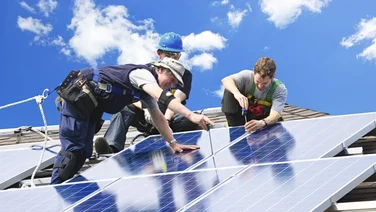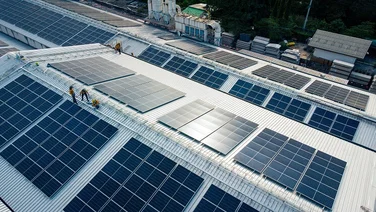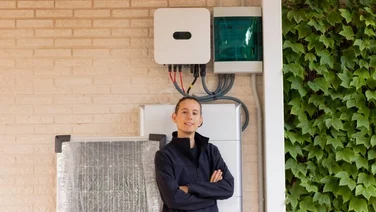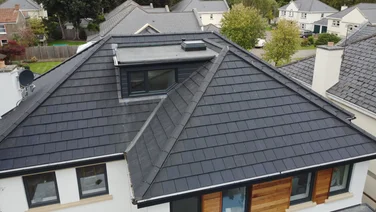- New solar panel technology
- Solar water purifiers
- Floating solar farms
- Solar skin
- Wearable solar
- Solar aeroplanes
- Bifacial solar panels
- Solar panels
- Solar power through synthetic quartz crystals
- Solar-powered drones support sustainable aviation
- Is solar the future?
- Transparent solar cells
- Solar-powered laptops
- Flexible solar panels
- Honorable mention - BYDs new energy storage system
- Summary
- Countries are increasingly developing and adopting solar power
- Solar purification combines the Suns UV rays and the heat it produces
- Floating solar farms helps save on inhabitable
- Bifacial solar panels convert sunlight into electricity using the photovoltaic effect
- Solar trees are equipped with solar panels that generate and store clean energy from the sun
Solar technology has many benefits. Investment can help lower bills – with the average three-bedroom household saving £467 per year – as well as reduce our planet’s carbon footprint, particularly with the cost of solar panels coming down.
The industry has recently experienced high levels of innovation and investment in both the private sector and from the government.
Were moving at a fast pace to generate new forms of solar technology, and it can be hard to keep up. Below, youll see a full rundown of all the latest pieces of technology and how theyll help us.
However, if youve already done the research and are ready to invest in solar technology, simply fill in this form to receive quotes from a wide range of our trusted suppliers.

New solar panel technology
The solar industry is always evolving, especially as the cost of solar panels continues to decline. Governments are increasingly developing and adopting solar power in a bid to become greener and meet their own net zero targets.
The challenge, however, is many of these innovations are unknown, with the exception of solar panels. To help, you can find out everything about these solar technologies in more detail below.
Well be covering:
- Solar water purifiers
- Floating solar farms
- Solar skins
- Wearable solar
- Solar panels
- Solar aeroplanes
- Bifacial solar panels
- Solar power through synthetic quartz crystals
- Flying solar panels
- Transparent solar cells
- Solar-powered computers
- Flexible solar cells

Get free solar panel quotes
Answer a few quick questions, and our trusted installers will send you bespoke solar panel quotes – for free.
Solar water purifiers
Solar water purifiers are designed to help make unclean water safe to drink. As it stands, 2 billion people currently drink contaminated water, according to the World Health Organisation.
Solar purification, as reported by Pure Water Tech, combines the suns UV rays and the heat the sun produces. These elements heat the water almost to a boiling point and change the makeup of the water, heating pathogens and contaminants in the process.
Many solar water purifiers are already operational around the world. For example, a solar-powered desalination system was developed by MIT (Massachusetts Institute of Technology) and in China can provide around seven litres of drinkable water per hour, for each square metre of the solar network.
The recommended guidance for water consumption is between 2.7 and 3.7 litres per day, including the water in food, which makes up 20% of our fluid intake. That means for the average person, 2.6-2.7 litres would be adequate, meaning a 100m2 version of MITs solar network would supply enough clean drinking water for 2,213 people, every day.
This technology has already been implemented in Kiunga, Kenya by a non-profit called GivePower. The system can provide 75,000 litres per day – enough to quench the thirst of more than 28,800 people.
Floating solar farms
Floating photovoltaic systems is the most-efficient way to expand solar capacity. They enable most countries to harness the 71% of the Earth thats covered by water – and exposed to sunlight.
Floating solar farms helps save on inhabitable space and produces significantly more energy. Studies have shown that floating solar farms generate electricity up to 11% more efficiently than land-based panels, because the water acts as a coolant.
Anhui, in eastern China, is home to the worlds biggest floating solar plant – a 150 MW system, which generates enough energy to power more than 40,000 homes. The region also boasts a 78 MW floating photovoltaic farm.
Europe has also started investing in such farms. The biggest European network is the 27.4MW network in Bomhofsplas, Netherlands, which opened in 2020.
The worlds five biggest largest floating solar plants are:
- Dezhou Dingzhuang floating solar farm, China: 320MW
- Three Gorges New Energy floating solar farm, China: 150MW
- CECEP floating solar farm, China: 70MW
- Sembcorp floating solar farm, Singapore: 60MW
- Sirindhorn Dam floating solar farm, Thailand: 45MW

Solar skin
Solar skin is a flexible, transparent material that is very thin but efficient in producing an electrical current when exposed to sunlight.
They are created with a selective light filtration system that preserves up to 99% of the energy yielded from natural sunlight. This technology is currently being celebrated for its ability to allow ample sunlight to be filtered through the thin membrane, while retaining its opaque property at the same time.
However, as reported by Just Solar, solar skins has an array of pros and cons:
Pros
- With solar skin, you get to enjoy the best of both worlds – saving 30-50% on electricity bills, while keeping the original design of your roof or even improving it visually
- As the name suggests, solar skins are compatible with any solar module on the market, saving you the restriction of purchasing only a specific brand or model
- Solar skins can increase the durability of your solar panels. The layer of film also protects the underlying arrays from UV corrosion and chemical degradation
Cons
- Naturally, an additional skin to your existing solar panels means an add-on cost. This downside might be negligible for homeowners who are looking to go green but are put off by the look of traditional solar panels
- Theres a possibility that the extra PV skin might affect the efficiency of solar panels. Nonetheless, researchers at the National Renewable Energy Lab in the US are looking to improve efficiency through product R&D testing

Get free solar panel quotes
Answer a few quick questions, and our trusted installers will send you bespoke solar panel quotes – for free.
Wearable solar
Wearable solar technology – also known as solar textiles – integrates solar panels into textiles, allowing users to harness solar energy through clothes or accessories.
According to Green.org, the process involves embedding photovoltaic cells or other energy-harvesting technologies directly into fabrics, enabling the conversion of sunlight into electrical energy.
Wearable solar technologies are relatively new, but they can be utilised in many industries, including outdoor recreation, healthcare and fashion. For outdoor recreation, wearable solar can help power portable devices, whereas in healthcare, they can be used to power medical devices and sensors.
Nottingham Trent University researchers have developed solar cells, which are 3mm x 1.5mm, which can be embedded into yarn, which can then be turned into clothing. 200 cells can produce up to 80 miliwatts, which helped charge a Fitbit during trials.
From the trials, the tech developers claimed that a clothing item interwoven with 2,000 of the wearable solar cells would be able to charge a smartphone. The cells are also coated with a waterproof resin, so theyre able to withstand the washing machine.

Get free solar panel quotes
Answer a few quick questions, and our trusted installers will send you bespoke solar panel quotes – for free.
Solar aeroplanes
Solar-powered aircrafts can be an aeroplane or blimp and use either a battery or hydrogen to store the energy produced by the solar cells. This then allows the plane to use the energy at night.
Solar Impulse was the first solar-powered plane to make a trip around the world in 2015-16, flying from Abu Dhabi to India, Myanmar, China, Japan, USA, Europe, and back to Abu Dhabi, which was a significant achievement for solar airplanes.
In 2023, a solar-powered aircraft successfully completed its first high-altitude flight into the stratosphere. Phasa-35 has a 35-metre wingspan and is intended for surveillance and communications use. It was developed by Prismatic, located in Hampshire.
The high-altitude flight lasted 24 hours and took off from Spaceport America in New Mexico.
Its not the first time it has tried test flights. In February 2020, the plane completed its first flight successfully at an Australian Air Force test range.
Bifacial solar panels
A bifacial solar panel generates electricity from its front and rear surfaces and are typically made with transparent back sheets, allowing light to pass through. They are also sometimes constructed with frames that expose the back side.
Bifacial solar panels convert sunlight into electricity using the photovoltaic effect, but each side has its own process. The front of the solar panel uses solar cells to absorb lights and generate an electric current, whereas the back generates electricity from light reflected from another surface, like the roof.
The energy bifacial solar panels generate depends on its size and where and how its installed. The weather also plays a role, as does location, intensity and direction of sunlight, time of year, efficiency and quality of the panels.
For a full rundown on bifacial solar panels, including pros, cons and costings, check out our Bifacial solar panels guide.

Get free solar panel quotes
Answer a few quick questions, and our trusted installers will send you bespoke solar panel quotes – for free.
Solar panels
The block of silicon that started it all, solar panels. While it was there at the very beginning of the renewable energy revolution and transition, doesnt mean its incapable of evolving.
An example of this includes Oxford Universitys solar spin-off company Oxford PV, who achieved 28% efficiency for its perovskite-silicon 1cm2 cell – which is approximately 40-56% better than the solar industrys standard efficiency of 18-20%.
Oxford PVs Dr Chris Case revealed in an interview with us last year about perovskite solar cells that the company has a roadmap that extends beyond 30% efficiency.
These updates point to a future in which solar energy becomes more cost-effective so customers and companies are more likely to naturally gravitate towards it.
Some advanced ground-mounted solar panels are also being introduced into public spaces, aptly named solar trees. These artificial trees are equipped with solar panels that generate and store clean energy from the sun. Solar trees are a costly investment, however, with prices of around £62,000 per structure.

Solar power through synthetic quartz crystals
A solar-powered device has achieved temperatures over 1,000C, raising hope that manufacturing with fossil fuels could soon come to an end.
The new concept uses synthetic quartz crystals to trap solar energy at high temperatures to produce various materials using clean energy. These materials include glass, steel and ceramics, which need temperatures over 1,000C and account for nearly a quarter of the worlds energy consumption.
The device was built by attaching the quartz crystals to an opaque silicon disk and made use of the thermal trap effect to harness sunlight at high levels of efficiency – which was previously unseen.
Solar-powered drones support sustainable aviation
A new ultralight and flexible solar cell module that is 20 times thinner than a strand of human hair can power a wide range of electronics anywhere there is light.
The module is made from a material called ‘perovskite’ and has been developed by researchers at the Johannes Kepler University Linz. The material is already proving to be an efficient and lightweight solution to facilitate self-sufficient energy generation over extended periods of times.

Christoph Putz, one of the study’s lead authors, said: “Ultra-thin and lightweight solar cells not only have enormous potential to revolutionise the way energy is generated in the aerospace industry, there are also a wide range of applications that include wearable electronics that can also benefit from this new technology.”
Finally, the solar cell modules deliver 20.1% efficiency while maintaining a high degree of flexibility. It also has a power density of 44W/g, which, according to the developers, is what puts it above other types of solar cell technologies.
Is solar the future?
Solar power is set to take over more of the renewable market, just as the popularity of fossil fuels fades in many developing countries – and it seems to hold the key to securing clean drinking water for the billions who dont have it.
As the dangers of climate change become increasingly obvious and a reliance on polluting fuel sources becomes unmanageable, countries are turning to solar for energy independence and a green future.
And thats wonderful, since leaps forward in green energy help all of us. Most recently, it was announced that renewable energy has exceeded 30% of the worlds electricity supply.
Its only going to grow, too, so if you want to benefit from the renewable revolution, just complete this form to receive solar panel quotes from local experts.
Transparent solar cells

Another interesting new solar technology is called transparent solar cells. As the name suggests, these cells allow visible light to pass through them while converting non-visible parts of the electromagnetic spectrum to generate electricity.
Designs vary, but most focus on the ultraviolet or infrared frequencies. Because of this, such units tend to look similar to regular glass, with others appearing tinted or coloured.
One prominent example comes from CitySolar, an EU-funded research project, which has teamed up with the University of Southern Denmark.
These cells have shown efficiencies of around 12.3% while retaining a transparency of 30%. Owing to this, they could be used as electrically generating windows in buildings.
We are in discussions with industry partners about the next steps; we can scale up what we have, but we need business partners, Professor Morten Madsen, from the University of Southern Denmark, stated.
Solar-powered laptops

Yet another interesting solar technology development is the advent of solar-powered laptops. Depending on the design, this is achieved either through built-in solar panels or more commonly via external solar chargers designed to power or charge the laptop battery.
One interesting example is Lenovos new range of solar-powered computers. These include the Yoga Solar PC (a proof-of-concept solar-powered laptop) and the Solar Power Kit for Yoga.
The former device is tailored for users who work in varied environments, from indoors to outdoors, and represents Lenovos vision of merging sustainability with high performance. According to Jun Ouyang, Lenovo’s senior VP, the laptop demonstrates a future where clean energy and tech go hand in hand.
The Yoga Solar PC features a solar panel with a conversion rate exceeding 24%, thanks to Black Contact Cell technology, which relocates gridlines to the rear to maximize light absorption.
Its Dynamic Solar Tracking and Solar-First Energy systems automatically optimize charging, even under low light. In optimal conditions, 20 minutes of sunlight yields up to an hour of video playback. It’s the world’s first ultraslim solar laptop weighing just 1.22kg and measuring 15mm thick.
The accompanying Solar Power Kit uses Maximum Power Point Tracking (MPPT) and features a detachable USB-C panel mounted on bags or tents for flexible charging.
It is important to note that while promising, experts caution that such devices are currently a supplement, not a replacement, for traditional charging.
Flexible solar panels

Yet another exciting new solar technology is flexible solar panels. These are generally lightweight, bendable photovoltaic sheets designed to generate electricity while conforming to curved or uneven surfaces.
One notable example has been developed by the Chinese solar manufacturer Polyshine Solar. Called the JY1-72HxxxPC 505535W, this ultra-lightweight, flexible solar module series was recently showcased at the 2025 PV Expo in Tokyo.
Explicitly designed for rooftop applications, the modules offer power outputs ranging from 505W to 535W, with 19% and 20.1% conversion efficiencies. Each panel measures 2,246mm x 1,185mm x 2.5mm and weighs just 7.5 kg (2.92kg/m²), making it 70% lighter than conventional glass panels.
Built with patented polymer encapsulation and ethylene vinyl acetate (EVA), the modules feature a bend radius of 0.5 meters, enabling installation on curved or low-load-bearing surfaces without retrofitting.
Polyshine claims the modules are ideal for accelerating global rooftop solar adoption due to their ease of installation, high UV blocking capability, and light transmittance above 91%.
They support peel-and-stick or strap-fastening options for quick deployment and come equipped with IP68-rated junction boxes. Operating in temperatures from -40°C to 85°C, the panels have a temperature coefficient of -0.28%/°C, ensuring stable performance across various environments.
Honorable mention – BYDs new energy storage system

While not technically a solar power innovation, BYD recently launched a new energy storage system that could rock the market. The Battery-Box HVE is a modular home energy storage system offering up to 70.92 kWh capacity (three towers of four modules each).
Its modular design allows flexible installation, rapid backup functionality, and compatibility with hybrid inverters. According to reports, it should be available in Europe starting in June 2025.
Summary
- Wearable solar technology – also known as solar textiles – integrates solar panels into textiles
- Solar water purifiers are designed to help make unsafe drinking water safer
- Floating solar farms enable most countries to harness the 71% of the Earth thats covered by water – and exposed to sunlight
- Solar skin is a flexible, transparent material that is very thin, but efficient in producing an electrical current when exposed to sunlight
- Solar Impulse was the first solar-powered plane to make a trip around the world in 2015-16, flying from Abu Dhabi
- A bifacial solar panel generates electricity from its front and rear surfaces and are typically made with transparent back sheets
- Some advanced ground-mounted solar panels are also being introduced into public spaces, aptly named solar trees







